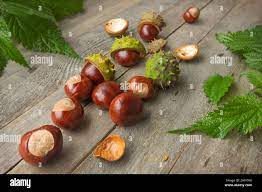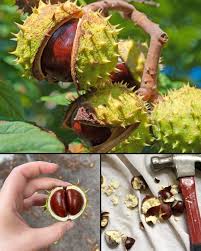The horse chestnut tree (Aesculus hippocastanum) is an incredible natural resource, offering a variety of practical applications. From traditional medicine to soap crafting, its seeds, bark, and extract provide numerous benefits. This guide outlines how to make the most of horse chestnuts in both medicinal uses and soap making.
Medicinal Uses of Horse Chestnut
Horse chestnut has been valued for centuries due to its therapeutic properties. Here’s a step-by-step approach to utilizing horse chestnuts for health purposes:
1. Preparing Horse Chestnut Extract:
- Harvesting Horse Chestnuts: Collect horse chestnuts in the fall when the spiky seed capsules split open. The shiny brown seeds inside are the key ingredient.
- Dehusking the Seeds: Carefully remove the hard outer shell to expose the seeds. Keep in mind that raw horse chestnuts contain toxic compounds, which must be removed during preparation.
- Slice and Dry: Cut the seeds into small pieces and allow them to dry in a cool, dry area, or use a dehydrator for faster drying.
- Create an Oil Extract: Combine dried horse chestnut seeds with a carrier oil (e.g., olive or coconut oil) in a 1:5 ratio. Seal the jar and store it in a dark, cool place for 6-8 weeks, shaking it every few days.
- Strain and Store: After the infusion period, strain the oil to remove the seeds and store the extract in a dark glass container. This oil can be applied topically for conditions like varicose veins and hemorrhoids.
2. Making Horse Chestnut Ointments:
- Ingredients Needed: You’ll need horse chestnut oil extract, beeswax (to solidify the ointment), and optional essential oils like lavender for added benefits.
- Preparation: In a double boiler, heat the oil extract and beeswax together in a 4:1 ratio until the beeswax melts and blends. Add essential oils if desired for fragrance and soothing effects.
- Pour and Cool: Pour the mixture into small containers like lip balm tins and allow it to solidify. Store in a cool, dark place and apply to areas with varicose veins, hemorrhoids, or bruises.
Soap Making with Horse Chestnut
Integrating horse chestnut into soap making yields nourishing skincare products. Here’s how to make your own:
Ingredients:
- Horse chestnut extract or oil
- Lye (sodium hydroxide)
- Water
- Oils and fats (e.g., olive, coconut, palm oil)
- Optional: Essential oils for fragrance
Safety Precautions:
- When handling lye, use protective gear (gloves and goggles).
- Work in a well-ventilated area to avoid inhaling fumes.
Soap Making Process:
- Prepare Lye Solution: Dissolve lye in water (note that this process generates heat and fumes). Allow it to cool before use.
- Mix Oils and Fats: Heat the oils and fats until melted, then allow the mixture to cool to the right temperature.
- Combine Lye and Oils: Slowly add the lye solution to the oils, stirring continuously until fully blended.
- Add Horse Chestnut Extract: Stir in 1-2 tablespoons of horse chestnut extract or oil per pound of oils. Adjust as desired.
- Fragrance (Optional): Add essential oils for fragrance, such as lavender or peppermint.
- Pour and Set: Pour the soap mixture into molds and allow it to set for several hours or overnight. Once firm, remove the soap and let it cure for several weeks to harden.
- Enjoy: After curing, your horse chestnut soap is ready for use. Enjoy its soothing and moisturizing properties during your skincare routine.

Important Disclaimer:
This guide provides educational information but is not a substitute for professional medical advice. Always consult with a healthcare provider before using any natural remedies, especially if you have health conditions, are pregnant, or take medications. Horse chestnuts contain toxic compounds, so safe preparation and dosage are essential.
Similarly, soap making involves handling potentially hazardous ingredients like lye. Follow all safety precautions to protect yourself and others during the process.
Conclusion:
The horse chestnut tree is an incredibly versatile resource with both medicinal and practical uses. By following these instructions, you can unlock its healing benefits and creative potential, whether in homemade remedies or custom skincare products like soap. Always exercise caution, educate yourself on the risks, and consult professionals when needed to ensure safe and effective use.
